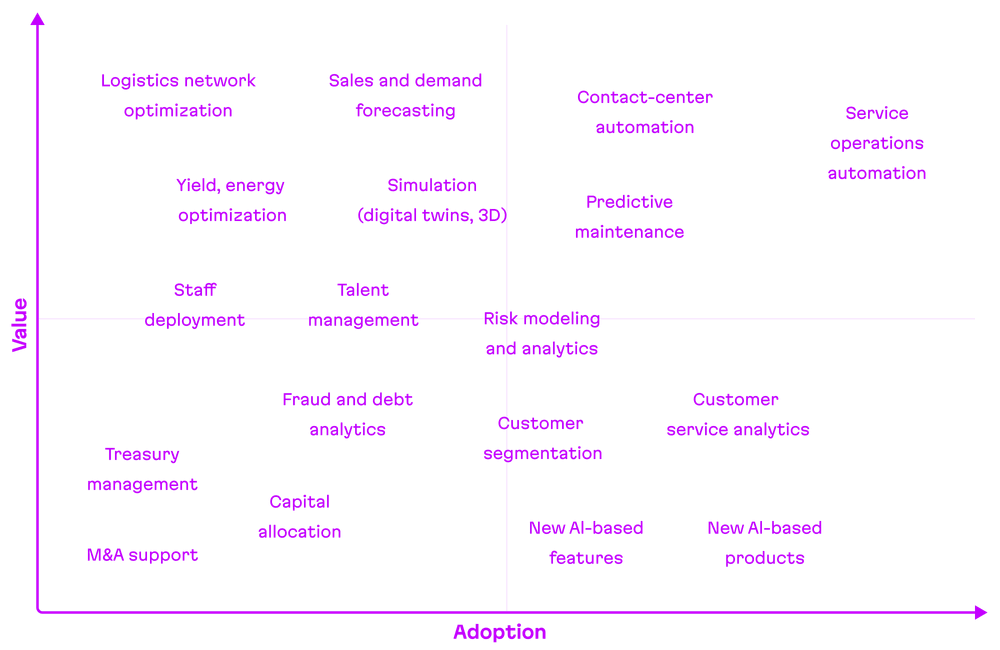“AI” marks the spot: a quick AI treasure map for businesses

Lately, the buzz surrounding AI has been ginormous. Language services like ChatGPT and image creators like Midjourney and Stable Diffusion have gone mainstream. It’s clear these AIs have been wowing everyone, not just hardcore techies. But for businesses in particular, there’s still even more lucrative AI exploration in store.
We’ll try to help you stay ahead in the AI game by uncovering some lesser-known gems. Plus, we’ll share some inspiring success stories to show how these solutions have made a real impact for businesses.
By now, it’s likely widespread knowledge that “AI” stands for artificial intelligence, but, for the purposes of this article, it’s probably useful to provide a general definition: AI refers to the general ability of computers to emulate human thought and to perform tasks in real-world environments. “AI” is also used as a catch-all term for smart technologies which solve tasks normally requiring human intelligence to complete.
The AI world encompasses a wide array of tools and solutions: recommendation engines, fraud detection, predictive analytics, sentiment analysis, chatbots, and a long list of other applications. By appropriately identifying and analyzing the diverse selection of currently existing technologies, companies can unleash their true potential and gain a competitive advantage.

Here are key 5 statistics on business AI adoption:
- 83% of companies consider using AI in their strategy to be a high priority.
- A significant 64% of businesses believe that artificial intelligence will help increase their overall productivity.
- About 28% of people fully trust AI, while 42% claim to generally accept it.
- Nine out of ten leading businesses have investments in AI technologies, but less than 15% deploy AI solutions at scale.
- 52% of companies accelerated their AI adoption plans due to the COVID crisis.
The struggles of adopting AI
Businesses attempting to effectively adopt AI solutions can often be met by various challenges. For example, a small startup might struggle with limited funds, making it difficult to bring AI experts on board, or to invest in the top-notch computing equipment required for training models. Additionally, time management becomes crucial when balancing a business’s core activities with AI projects, especially for smaller teams.
Businesses, particularly those new to AI, or those with fewer resources, might also face issues or lack experience with effective data management. Many organizations might not be aware of the processes involved in collecting, cleaning, and preprocessing data, which are all critical for properly training AI models. These obstacles can result in less accurate models, causing companies to miss out on the benefits that AI-driven insights could provide them.
Case study 1: enhancing the retail fashion experience
Stitch Fix is a personal styling company that uses ML algorithms to select clothing for their customers. By collecting data on customer preferences, such as style, fit, and budget, Stitch Fix’s algorithms can predict which clothes a customer will like and suggest them in their personalized styling recommendations. The company uses a combination of natural language processing and computer vision to extract information from customer feedback and images to further improve their algorithms. Stitch Fix’s use of ML has allowed them to personalize their offerings to individual customers, leading to higher customer satisfaction and increased sales.
Case study 2: evaluating a car condition and pricing
The process of buying and selling a car can be challenging due to varying vehicle conditions and the difficulty of determining a fair price. Carro, a leading Southeast Asian auto marketplace, addresses this problem by utilizing AI and ML technology. Their innovative solution employs computer vision to accurately identify vehicles, and thoroughly check a car’s condition. At the same time, it also optimizes pricing to ensure transparency and fairness. By utilizing these particular AI/ML solutions Carro elevates the car buying and selling experience, providing customers with a fair, transparent, and efficient shopping journey.
The benefits of using AI platforms with APIs
Despite the potential challenges outlined above, actually adopting AI solutions doesn’t have to be daunting: most AI platforms offer user-friendly APIs that allow businesses to access and integrate various AI features without the need for in-house development, saving time and resources.
These platforms often come with pre-trained models, which take advantage of extensive dataset training and are primed for real-world tasks.
An exciting aspect of these AI platforms is the ability to upload or import custom data to fine-tune the pre-trained models, making them more relevant to specific business needs.
This helps businesses overcome the lack of training data and still benefit from AI-driven insights. Here’s an example of using an AI platform API for converting a book’s scans to the book’s summary and insights:

Working with an AI platform API usually involves a few key steps:
- Selecting the desired AI functionality, such as recommendation engines or sentiment analysis.
- Accessing the platform’s API documentation and integrating it into your existing systems.
- Uploading or importing custom data, if necessary, to fine-tune the pre-trained models.
- Monitoring and evaluating the performance of the AI models in real-time, and making adjustments as needed.
Some of the top AI platforms accessible via API include Google’s Vertex AI, Microsoft’s Azure AI, AWS AI Services, IBM Watson, OpenAI, ParallelDots, Rev.ai, Stability.ai, and Wit.ai.
Case study 3: interacting with API in human language
HTTPie, a popular API development platform, identifies the challenges developers face when creating and testing API requests: these tasks require a deep understanding of API structure and HTTP protocols. To address this issue, HTTPie introduced HTTPie AI, an innovative feature that leverages artificial intelligence to enable users to interact with APIs using human language. So how did they get here? They utilized OpenAI’s GPT-3 models, thus enabling HTTPie AI to simplify the request generation process, allowing users to describe their intent or request components directly in the platform’s interface using natural language. This transformative solution not only streamlines the API development process but also paves the way for AI-powered assistance in creative tools.
Possible concerns
There are several ethical concerns about AI, including the fear that AI-enabled systems will replace workers across a wide range of industries. The use of AI during the pandemic has also reopened concerns regarding privacy, data protection, and the use of data beyond the needs of virus-tracking. Other ethical issues in artificial intelligence include bias and discrimination in decision-making processes, transparency and accountability in AI systems, safety and security risks associated with autonomous systems, and the impact of AI on social inequality. As AI takes a bigger decision-making role in more industries, it is important to address these ethical concerns to ensure that AI is developed and used responsibly.
Final musings
There’s no doubt that AI platform APIs can bring numerous benefits to businesses. By leveraging pre-built APIs, businesses can save time and resources on building their own AI models and algorithms, as well as accelerate the integration of AI into their existing workflows. This can lead to improved efficiency, productivity, and decision-making capabilities. Additionally, alternative ML tasks such as anomaly detection, forecasting, and natural language processing can provide valuable insights and predictive capabilities to businesses, helping them stay competitive in today’s rapidly evolving market. Overall, incorporating AI and ML technologies can bring significant benefits to businesses, ranging from cost savings to improved performance and innovation.
AI is still no replacement for Evil Martian expertise! Do you have a project that requires expert problem solving with AI solutions or machine learning? What about product design, frontend development, or backend development? Looking to get your project off the ground? Reach out to us

